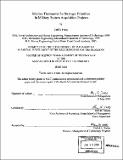| dc.contributor.advisor | John R. Hauser. | en_US |
| dc.contributor.author | Frank, Carl Bernard | en_US |
| dc.contributor.other | Management of Technology Program. | en_US |
| dc.date.accessioned | 2005-08-22T23:59:15Z | |
| dc.date.available | 2005-08-22T23:59:15Z | |
| dc.date.copyright | 2000 | en_US |
| dc.date.issued | 2000 | en_US |
| dc.identifier.uri | http://hdl.handle.net/1721.1/9272 | |
| dc.description | Thesis (S.M.M.O.T.)--Massachusetts Institute of Technology, Sloan School of Management, Management of Technology Program, 2000. | en_US |
| dc.description | Includes bibliographical references (leaves 63-65). | en_US |
| dc.description.abstract | Innovation and rapid fielding ("commercialization") of superior technology has been a key element in the United States military's strategy throughout its history. Maintaining this edge in the current environment of increased rate of technological change but dramatically reduced military procurement budgets will require strategically developing the most cost effective systems and optimizing the productivity of new product development teams. An emerging framework for a "metrics thermostat" based on an agency theory model for selecting and prioritizing metrics for product development teams has shown promising results in two commercial applications. This study focused on applying this framework to one of the government's largest procurement organizations, the Naval Sea Systems Command (NA VSEA), the Navy Department's central activity for designing, engineering, integrating, building and procuring U.S. naval ships and shipboard weapons and combat systems. A working metrics hierarchy and construct was developed. Desired outcomes or profit analogies were defined to value and differentiate strategic priorities, enabling metrics and covariates. Five strategic priorities aligned with NA VSEA' s stated goals were selected for the study and enabling metrics and covariates directly impacting these strategic priorities and desired outcomes were defined. Approximately 50 product/systems were identified and investigated to varying degrees. Significant progress was made toward populating the defined data fields for the selected data points/systems. Preliminary analyses offer hope that the combination of a large data set and broad, robust metrics will reveal meaningful correlations and leverages. The data sources have been largely been identified but substantial data collection remains to be done. As this is completed, comprehensive regression analyses will be performed to determine the relative effectiveness of the strategic priorities and enabling metrics. These results, and corresponding directions to program mangers on which strategies and metrics to emphasize and which to de-emphasize, will be validated by NA VSEA experts. | en_US |
| dc.description.statementofresponsibility | by Carl B. Frank. | en_US |
| dc.format.extent | 65 leaves | en_US |
| dc.format.extent | 5093909 bytes | |
| dc.format.extent | 5093666 bytes | |
| dc.format.mimetype | application/pdf | |
| dc.format.mimetype | application/pdf | |
| dc.language.iso | eng | en_US |
| dc.publisher | Massachusetts Institute of Technology | en_US |
| dc.rights | M.I.T. theses are protected by copyright. They may be viewed from this source for any purpose, but reproduction or distribution in any format is prohibited without written permission. See provided URL for inquiries about permission. | en_US |
| dc.rights.uri | http://dspace.mit.edu/handle/1721.1/7582 | |
| dc.subject | Management of Technology Program. | en_US |
| dc.title | Metrics thermostat for strategic priorities in military system acquisition projects | en_US |
| dc.type | Thesis | en_US |
| dc.description.degree | S.M.M.O.T. | en_US |
| dc.contributor.department | Management of Technology Program. | en_US |
| dc.contributor.department | Sloan School of Management | |
| dc.identifier.oclc | 45743529 | en_US |
